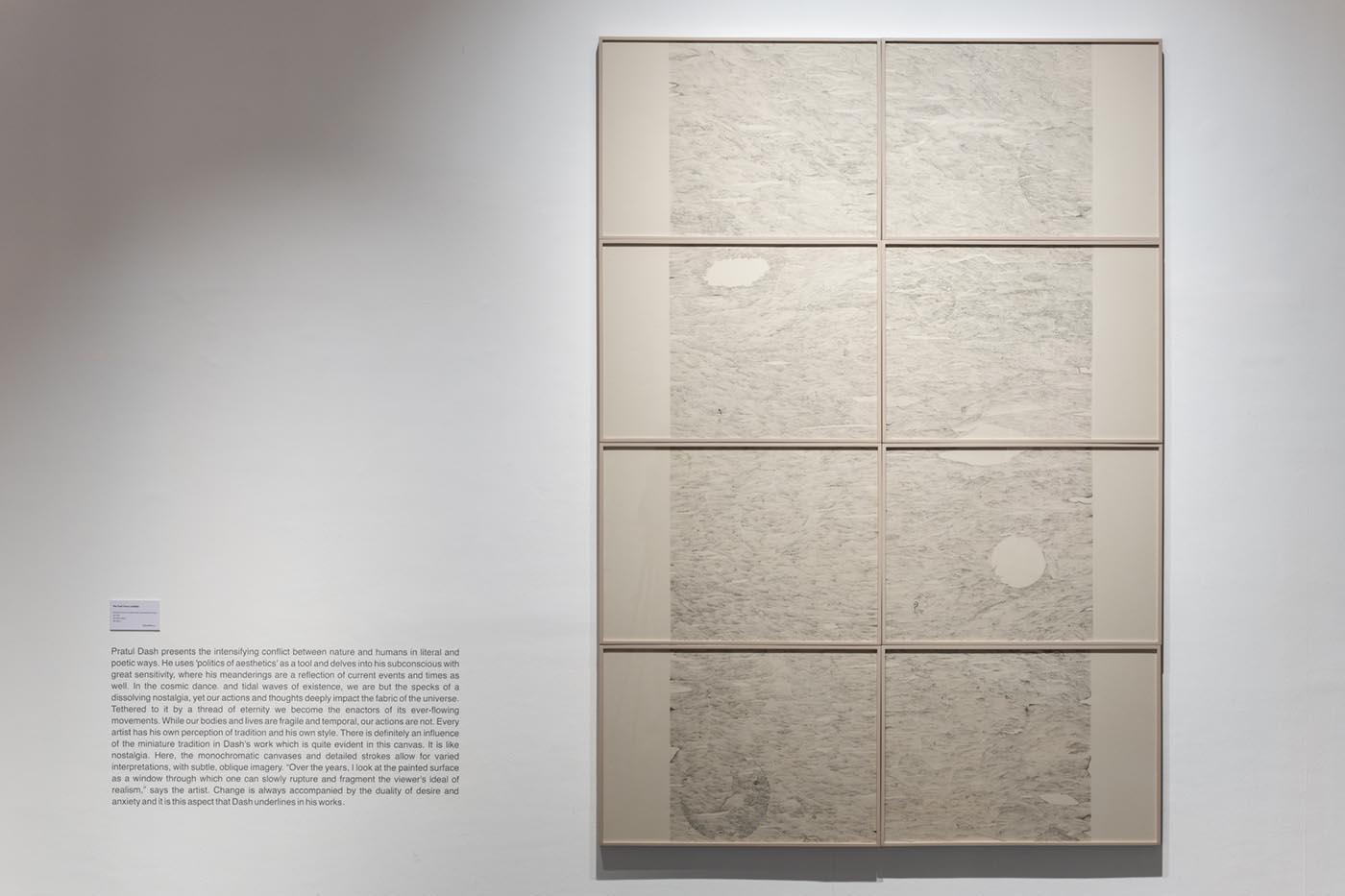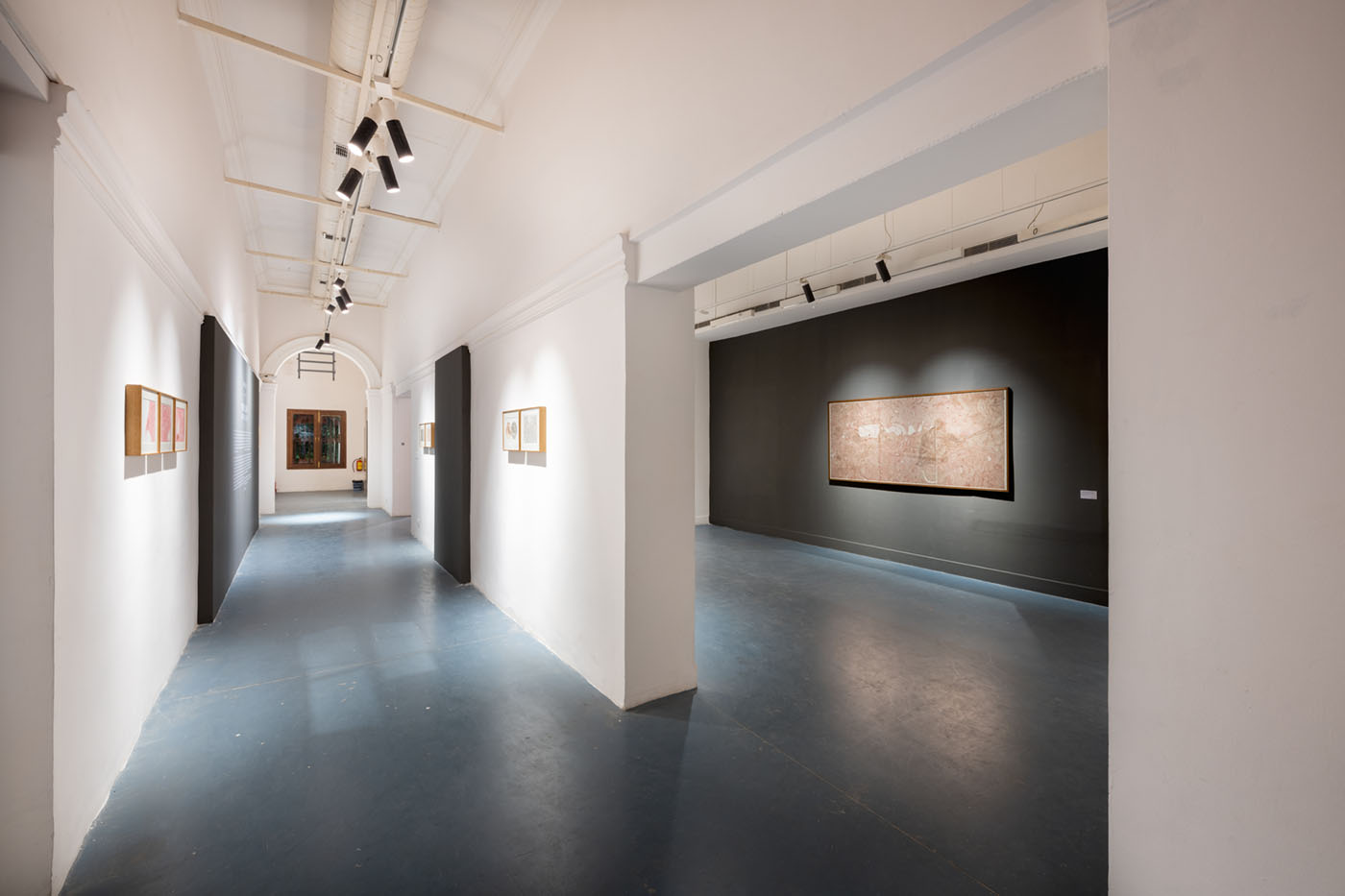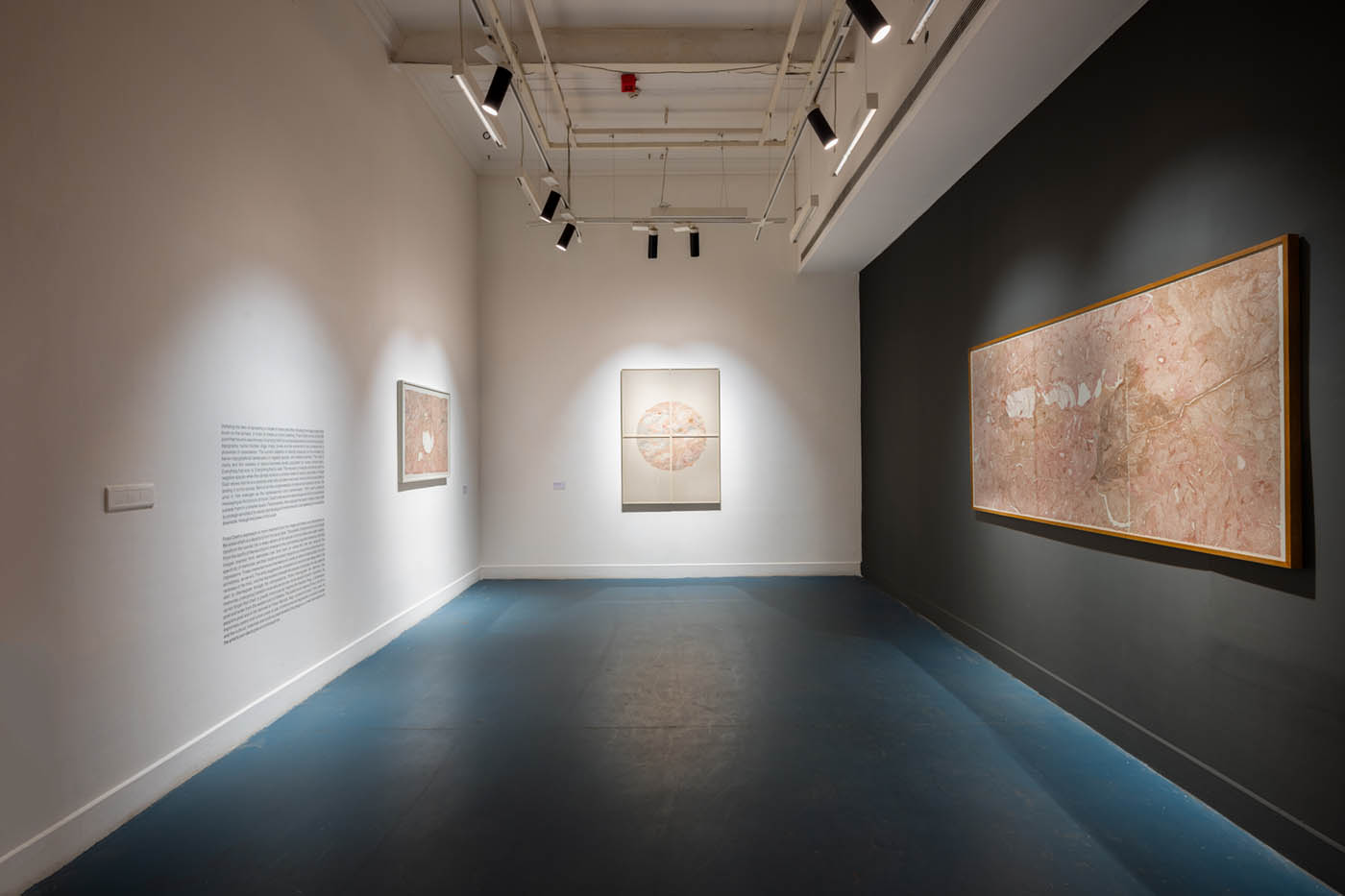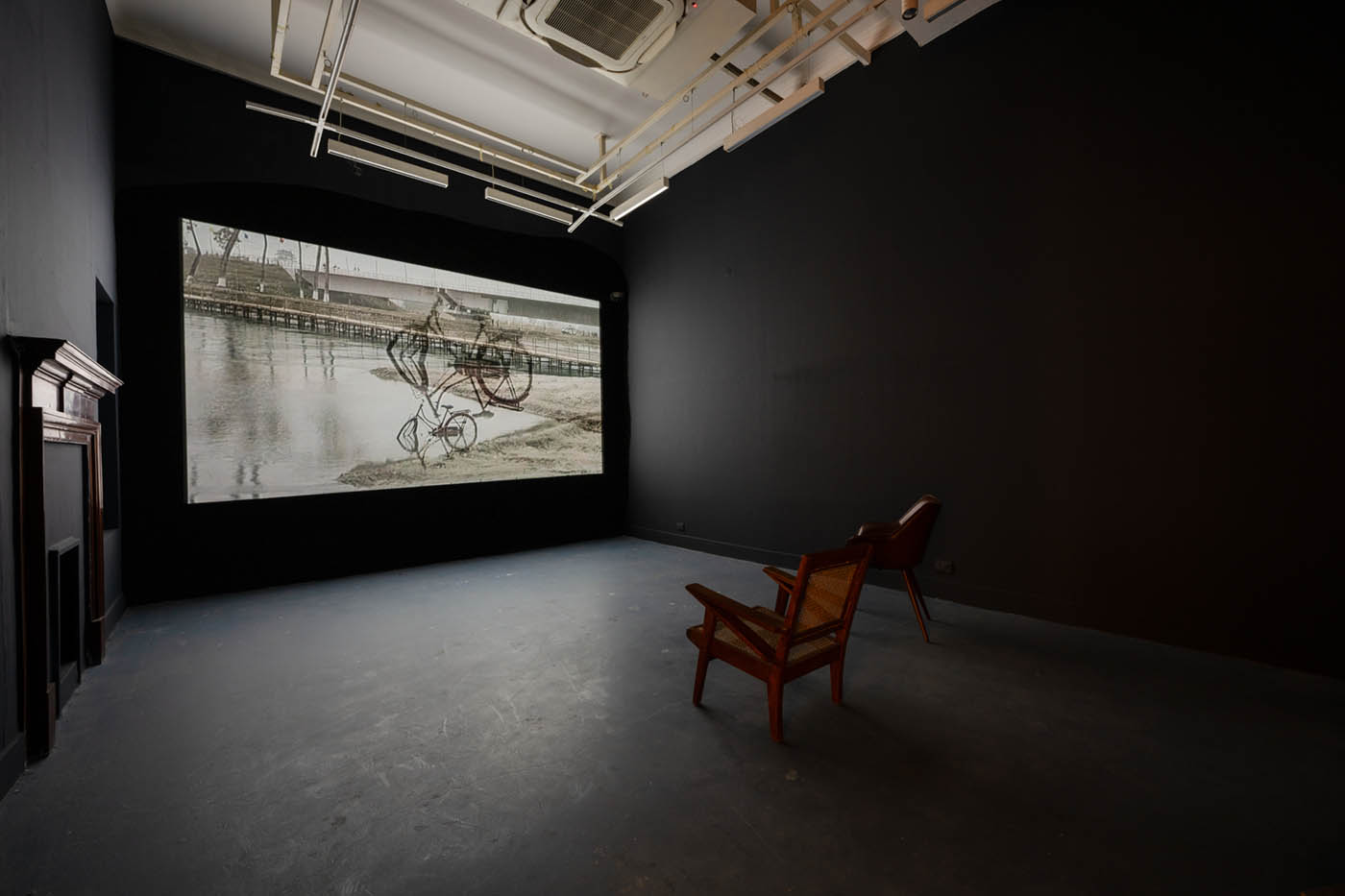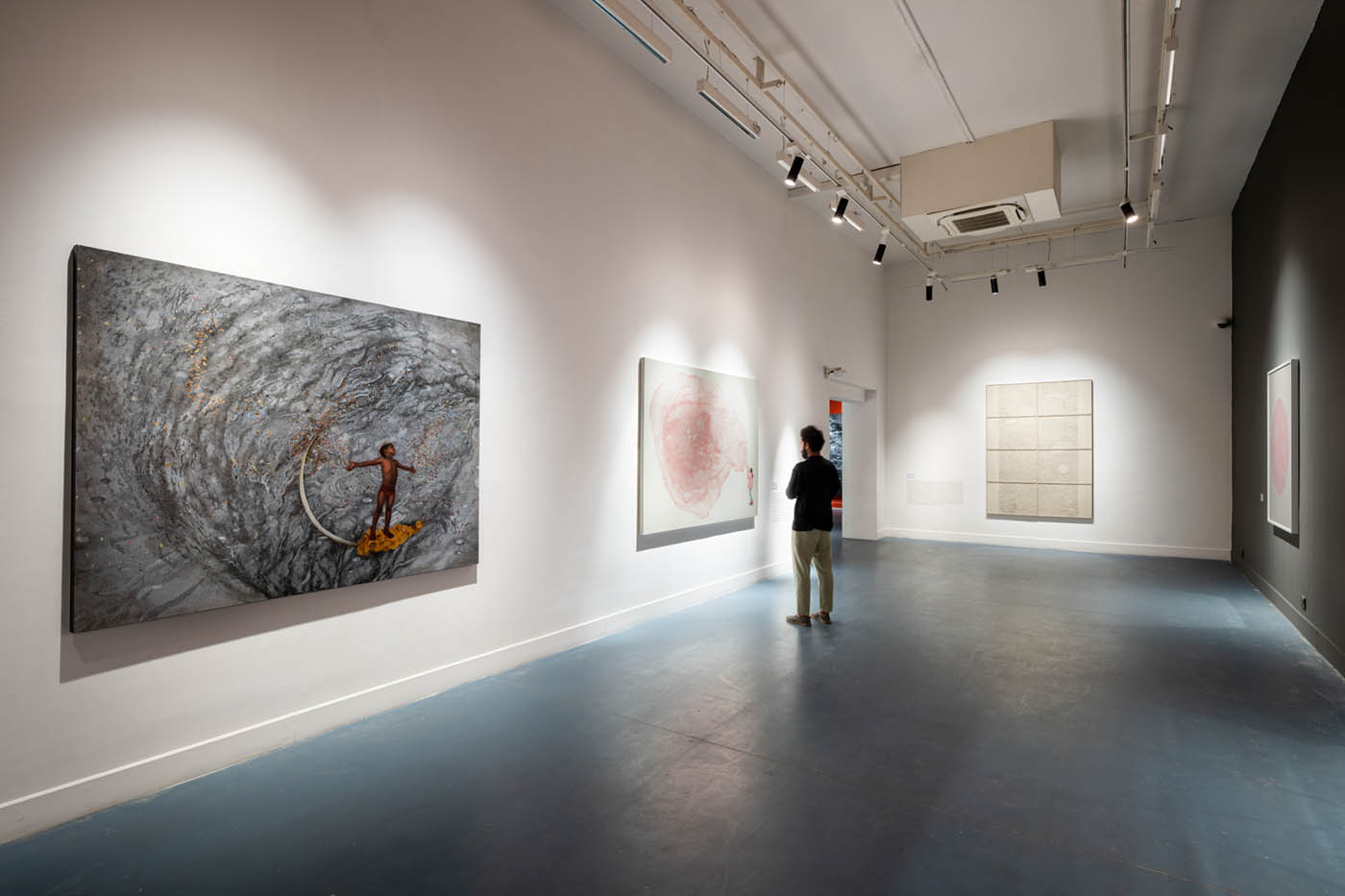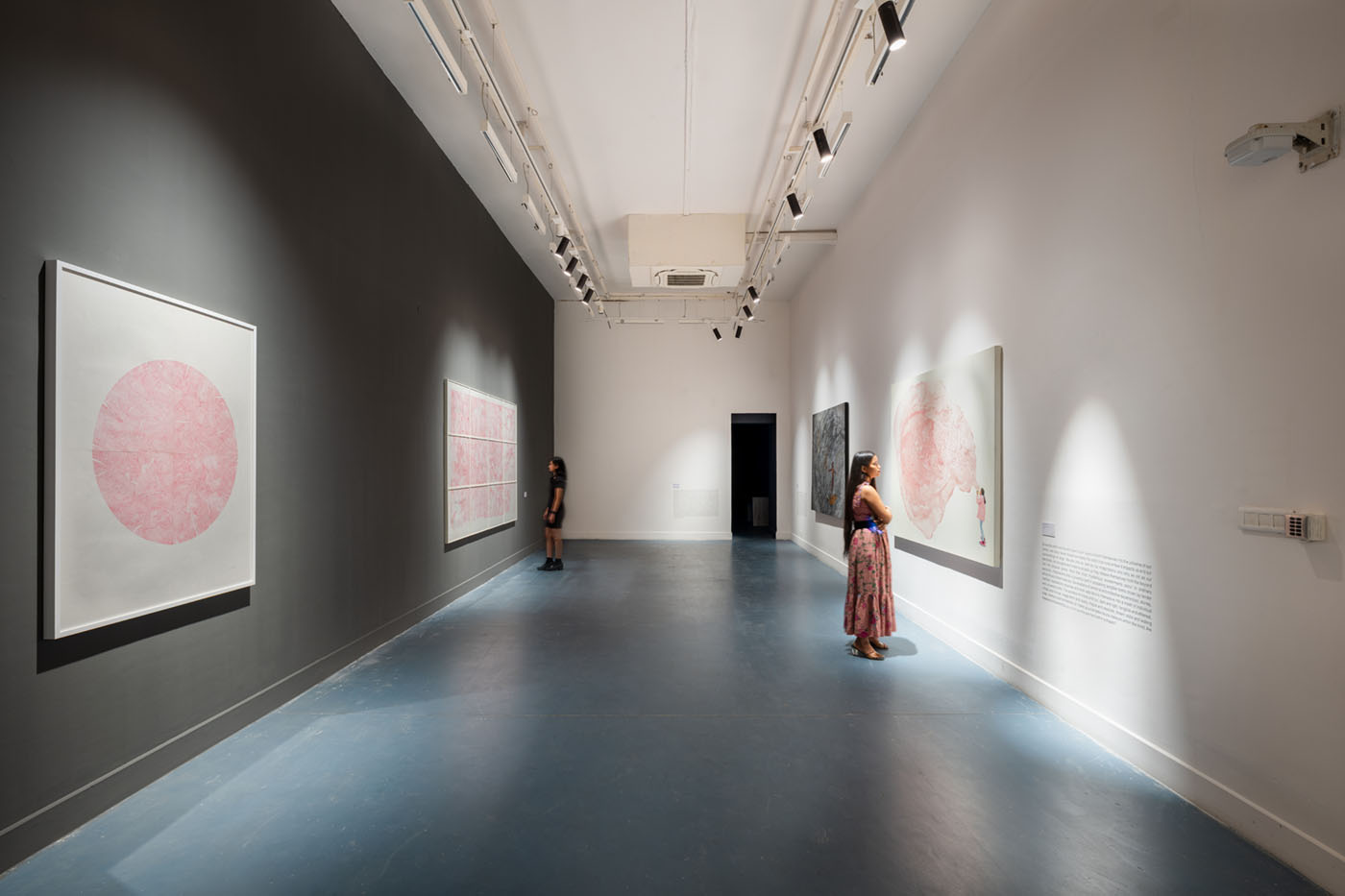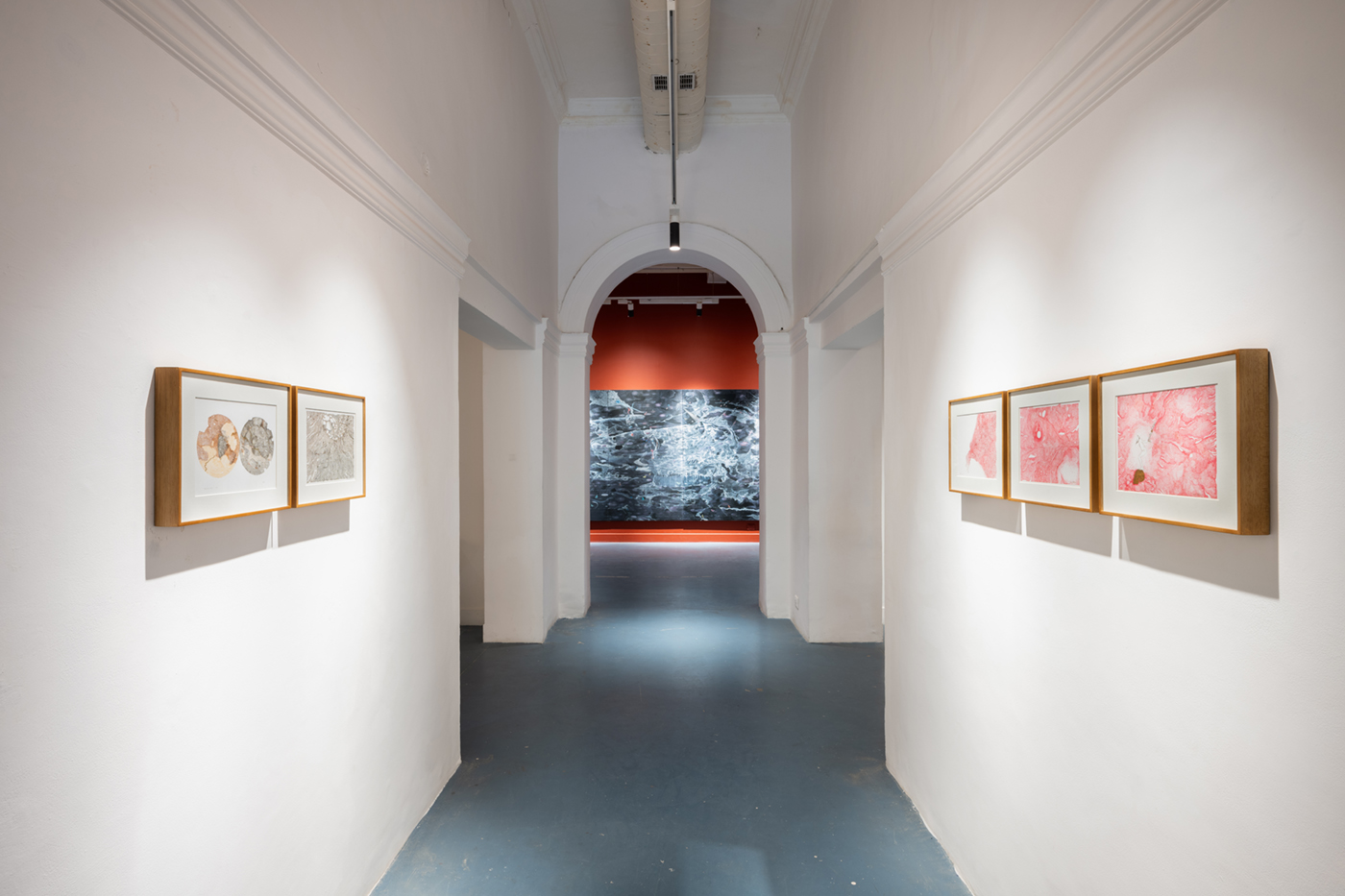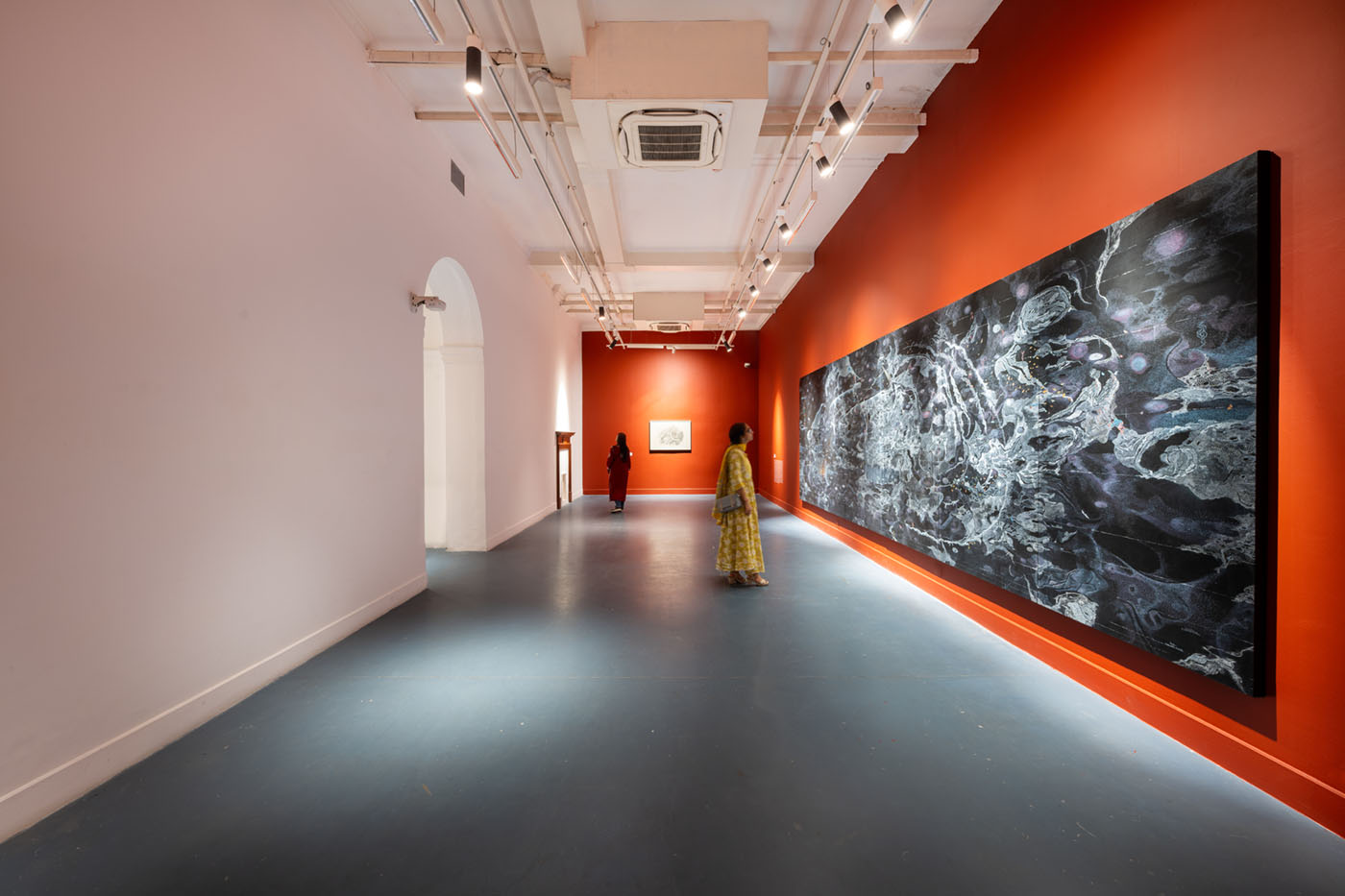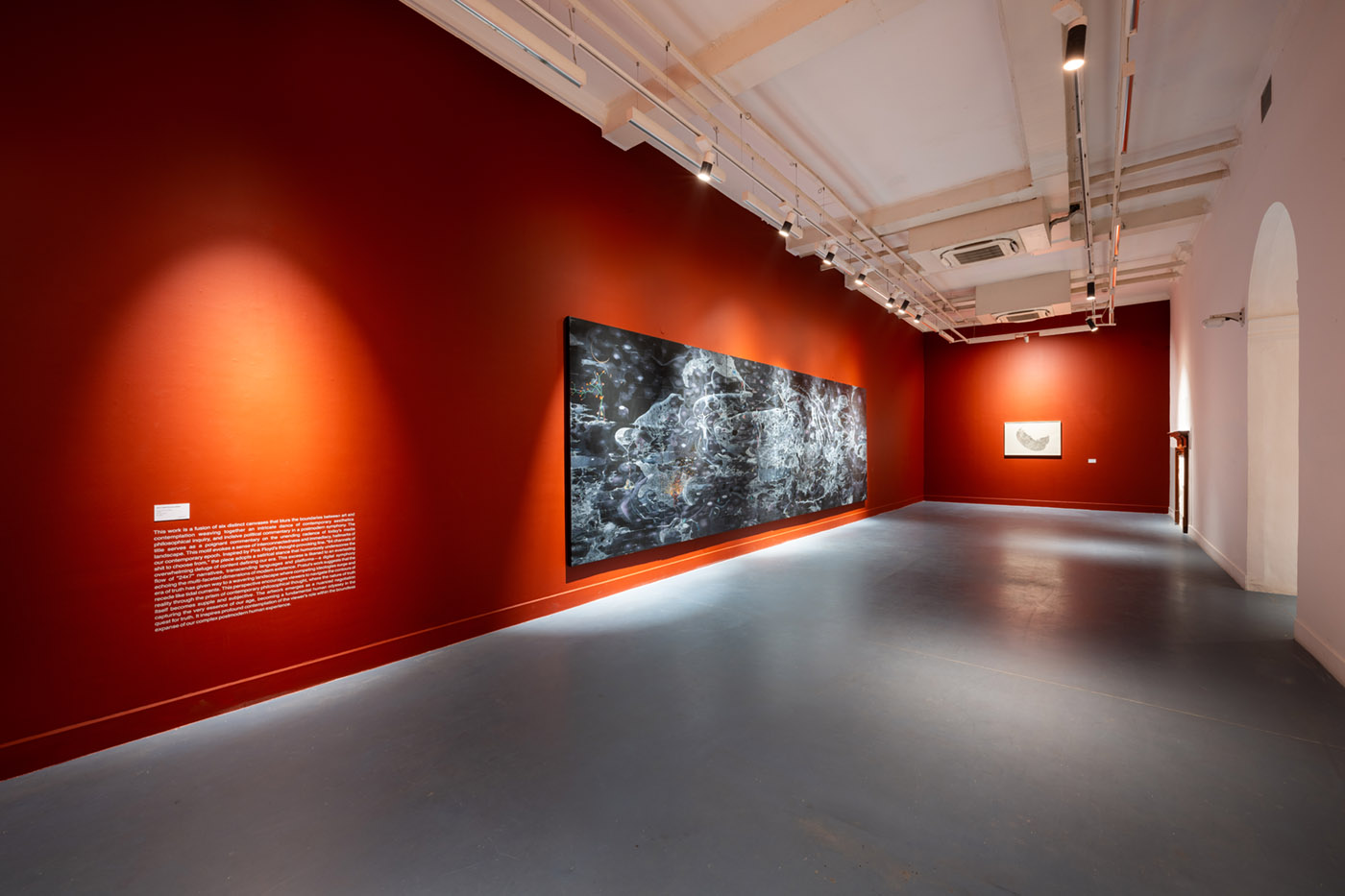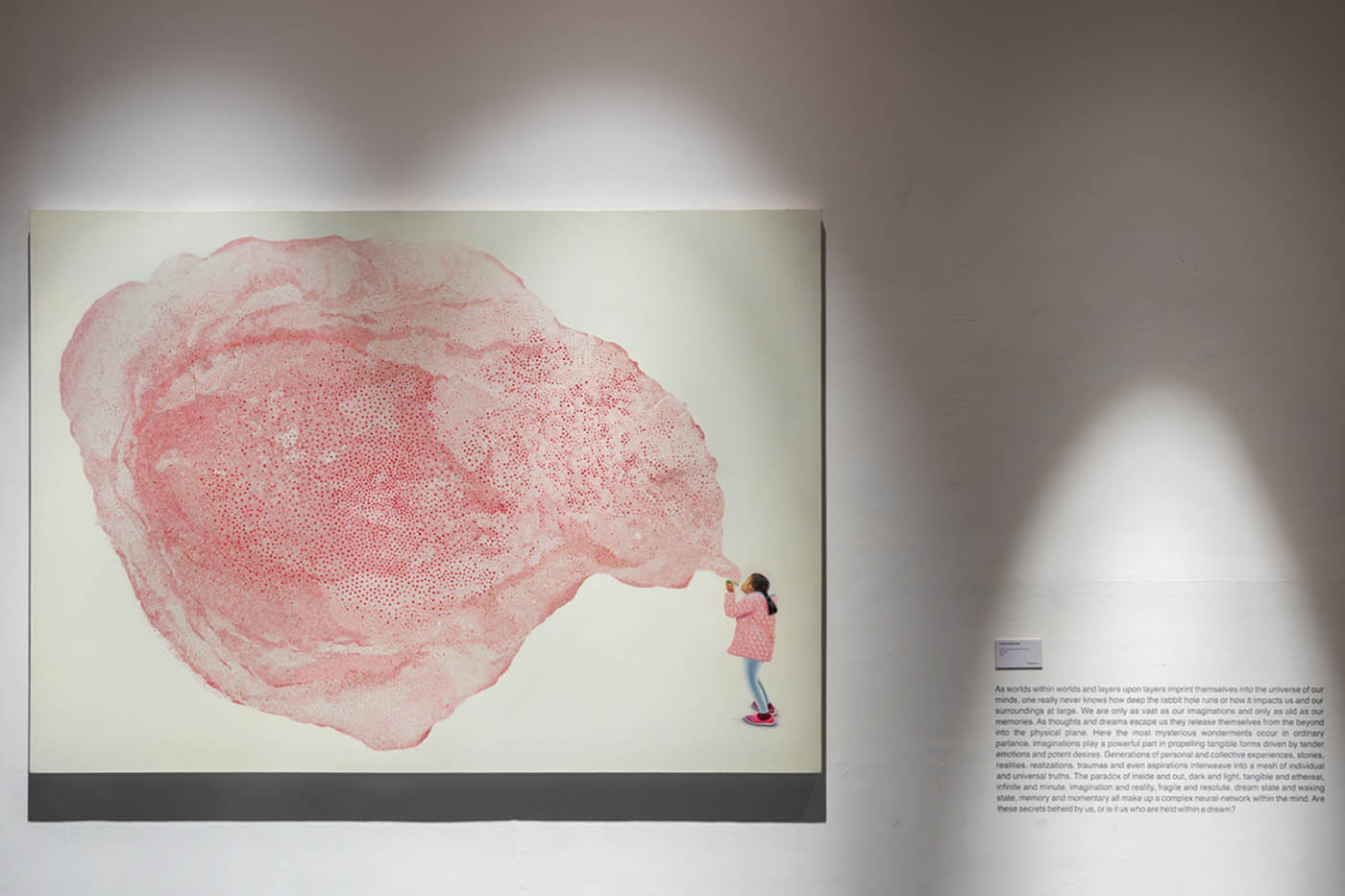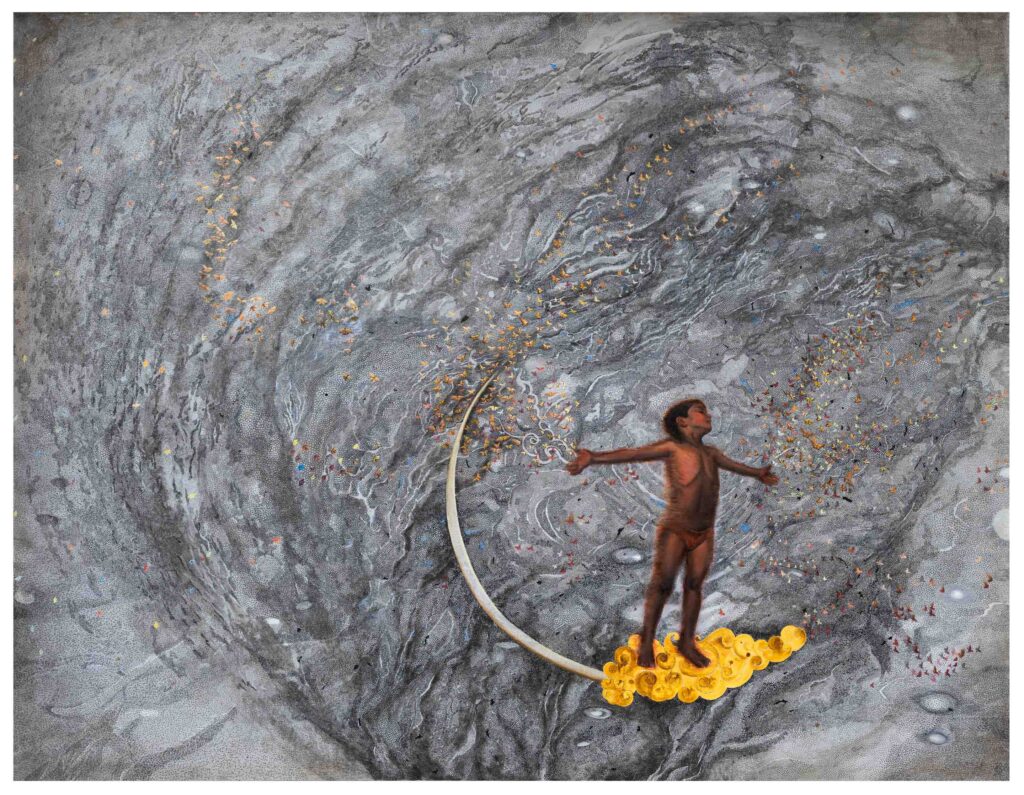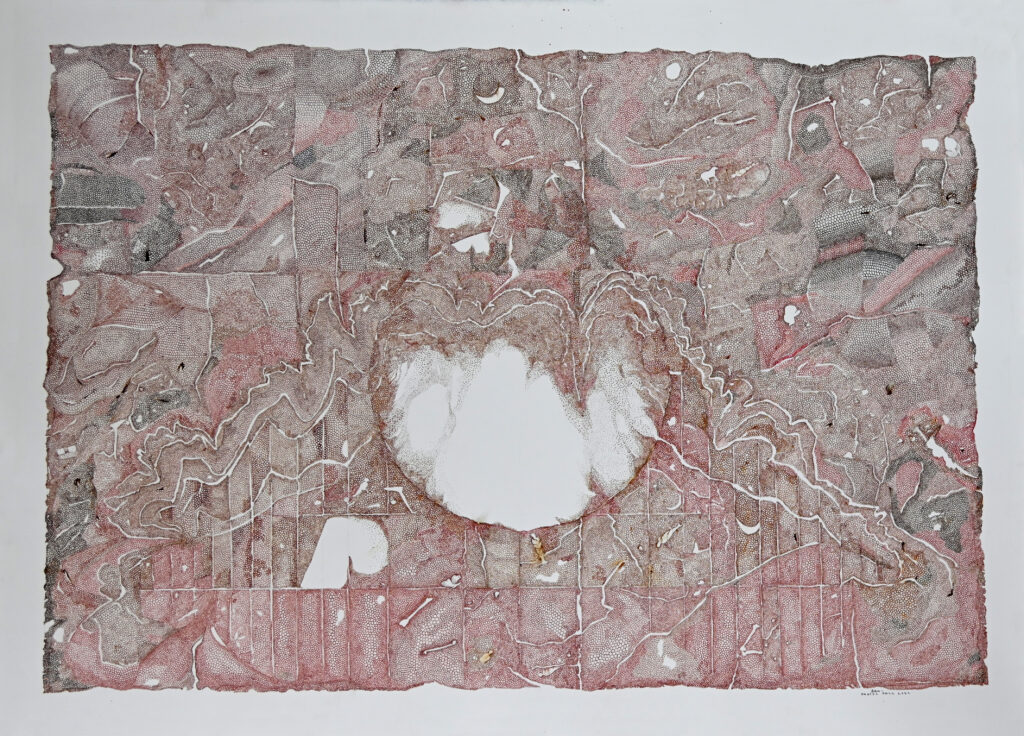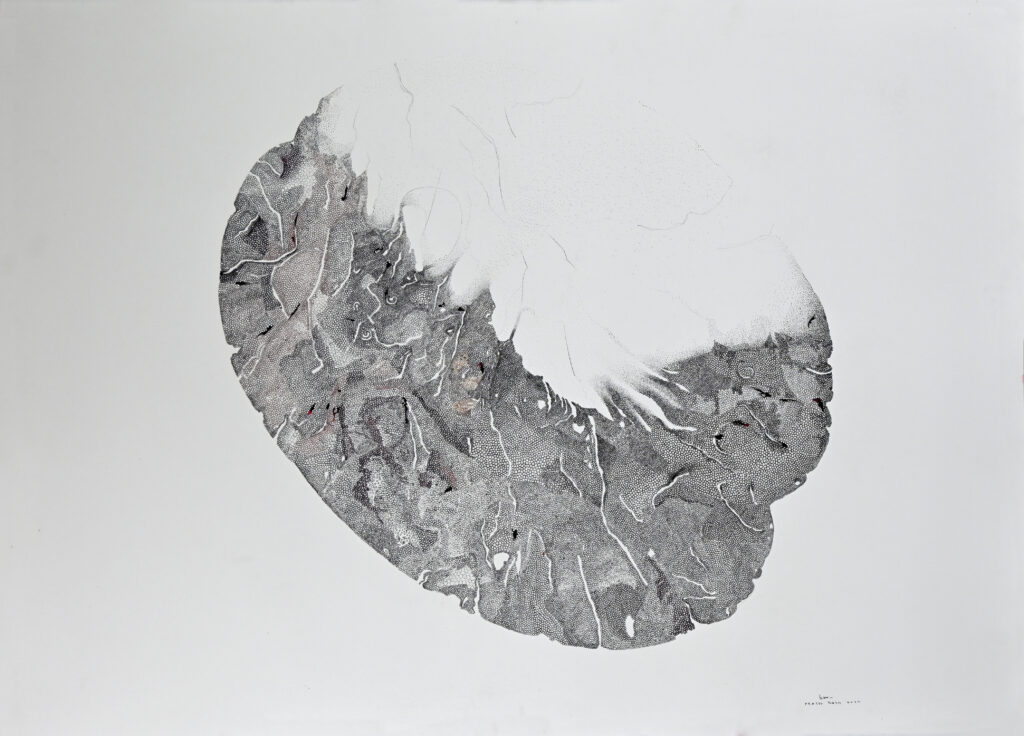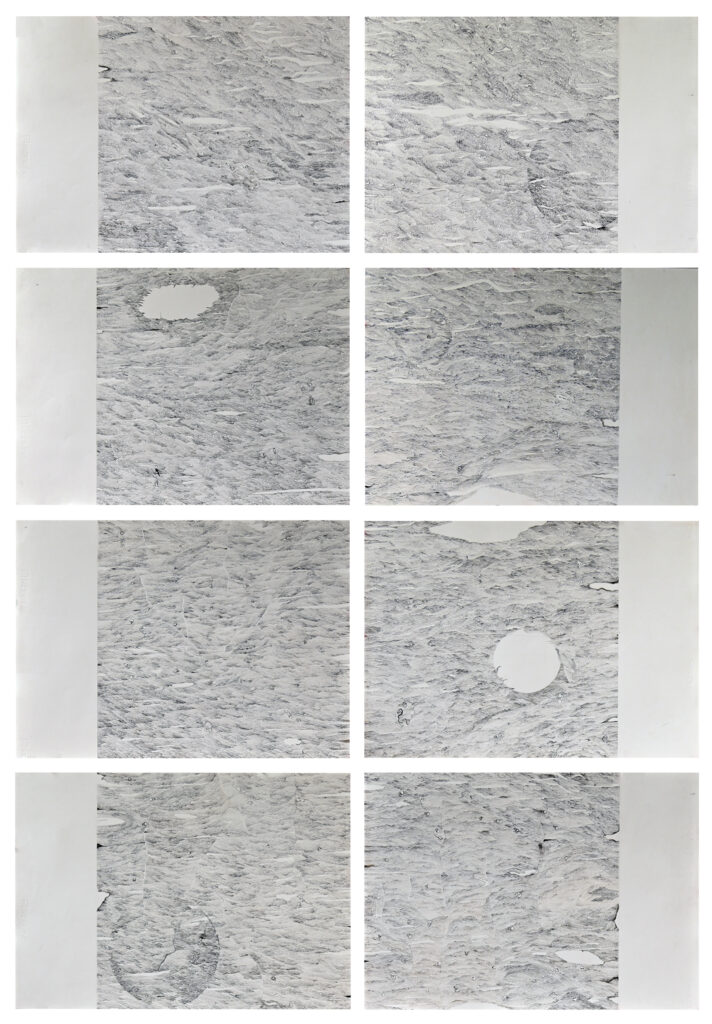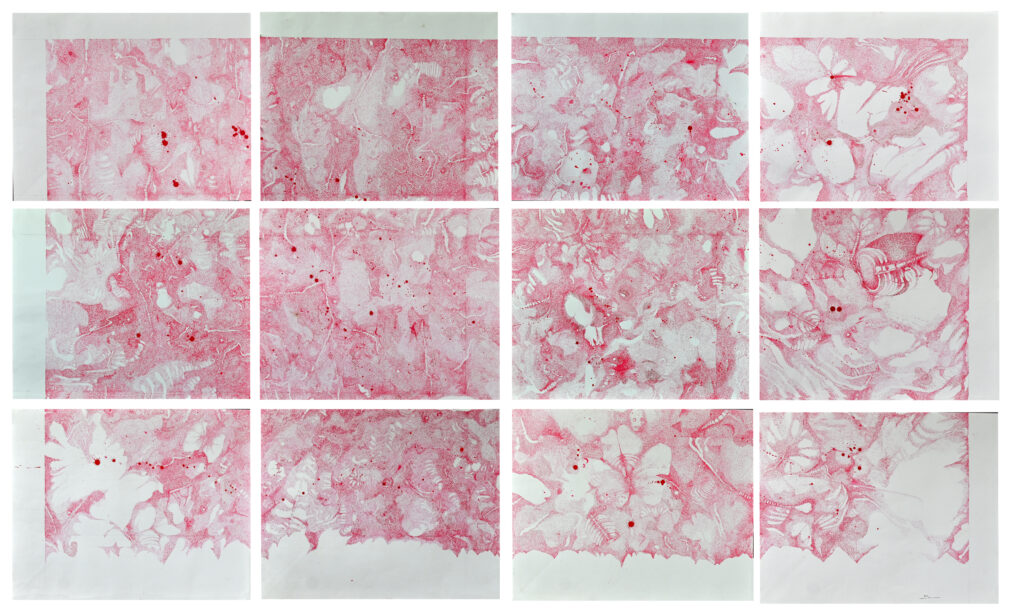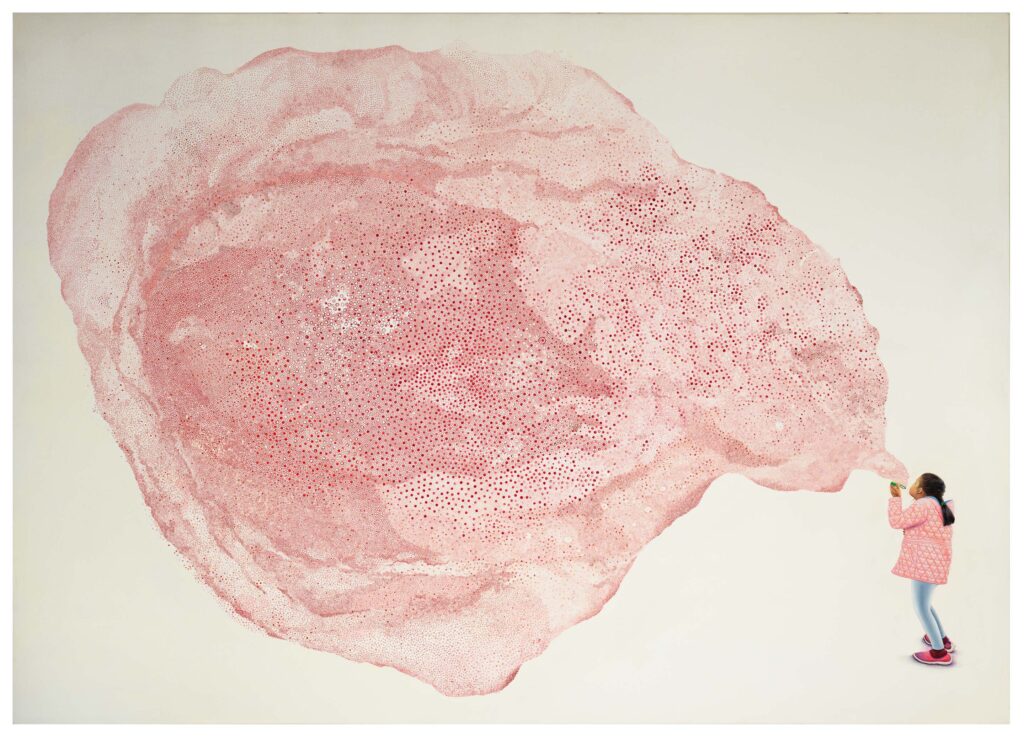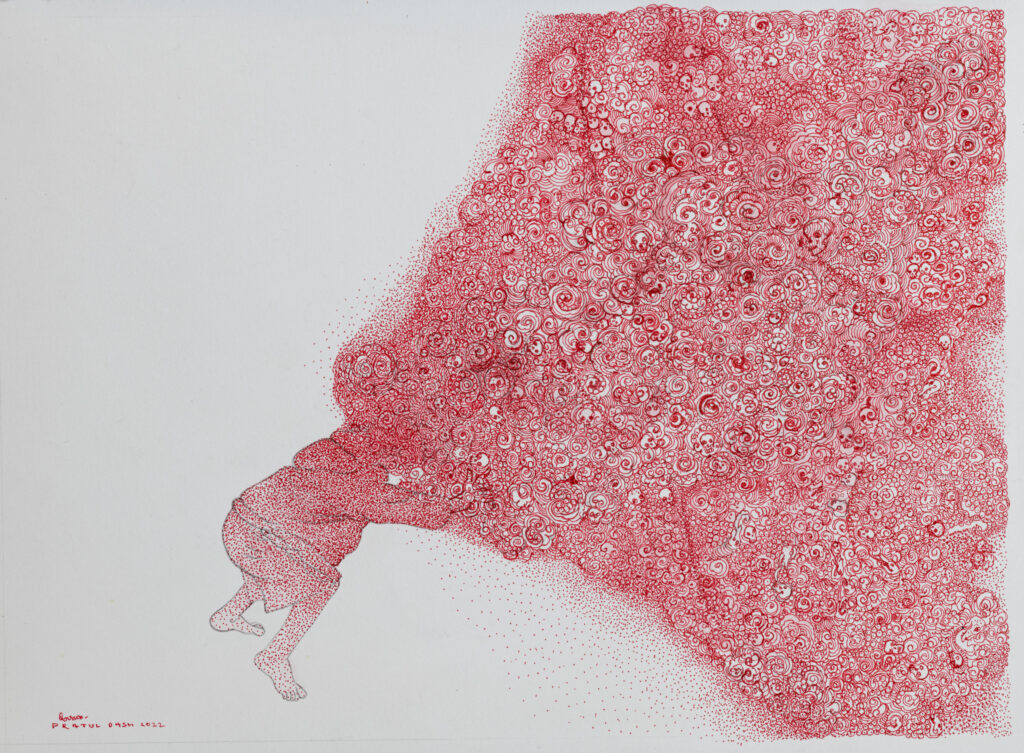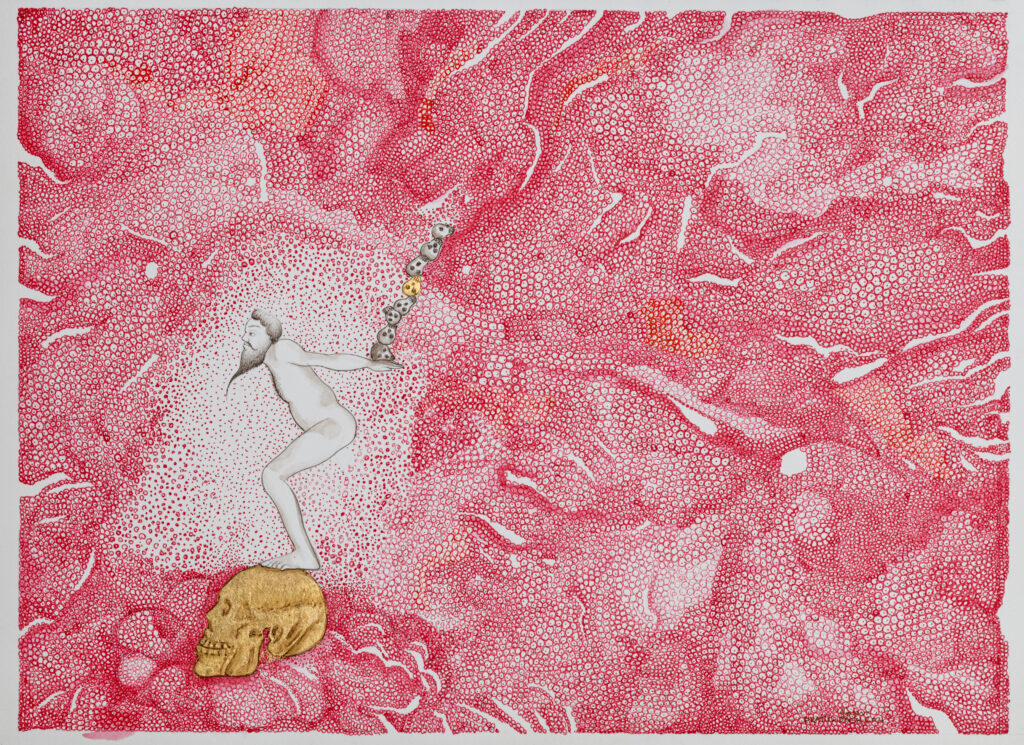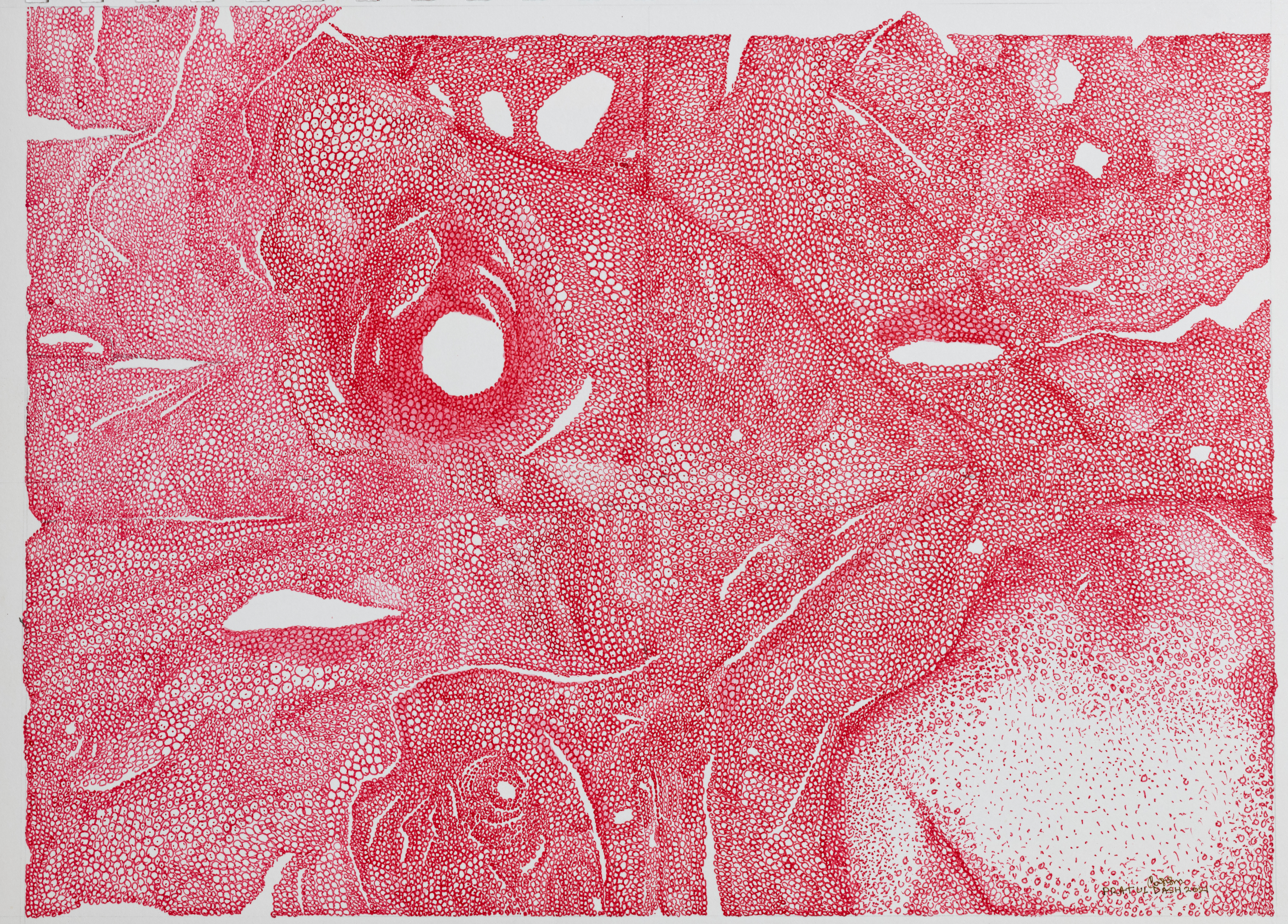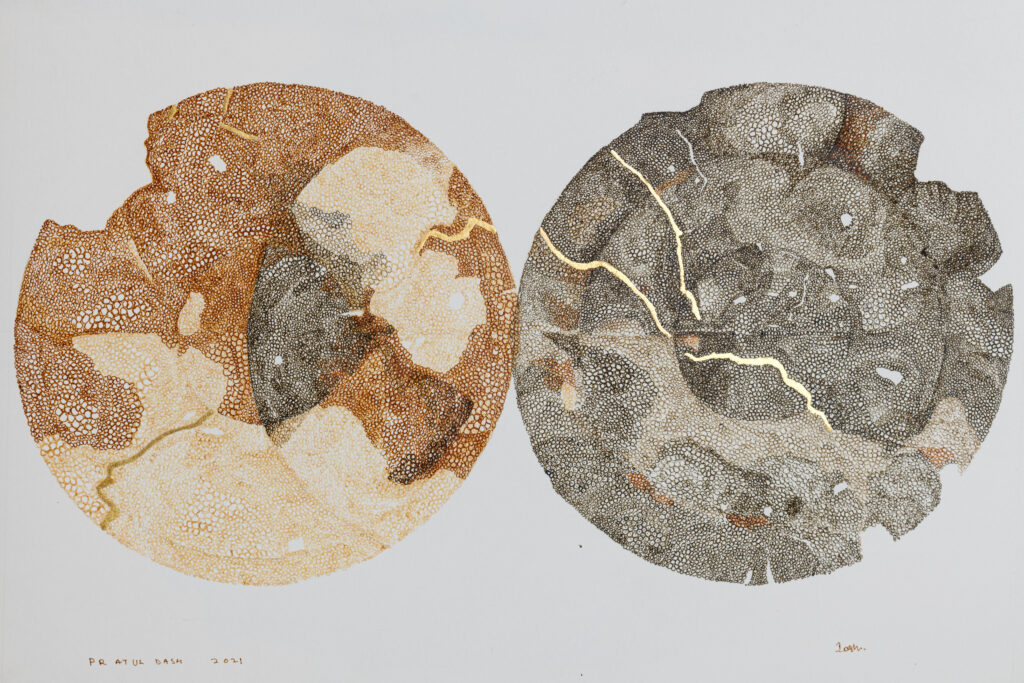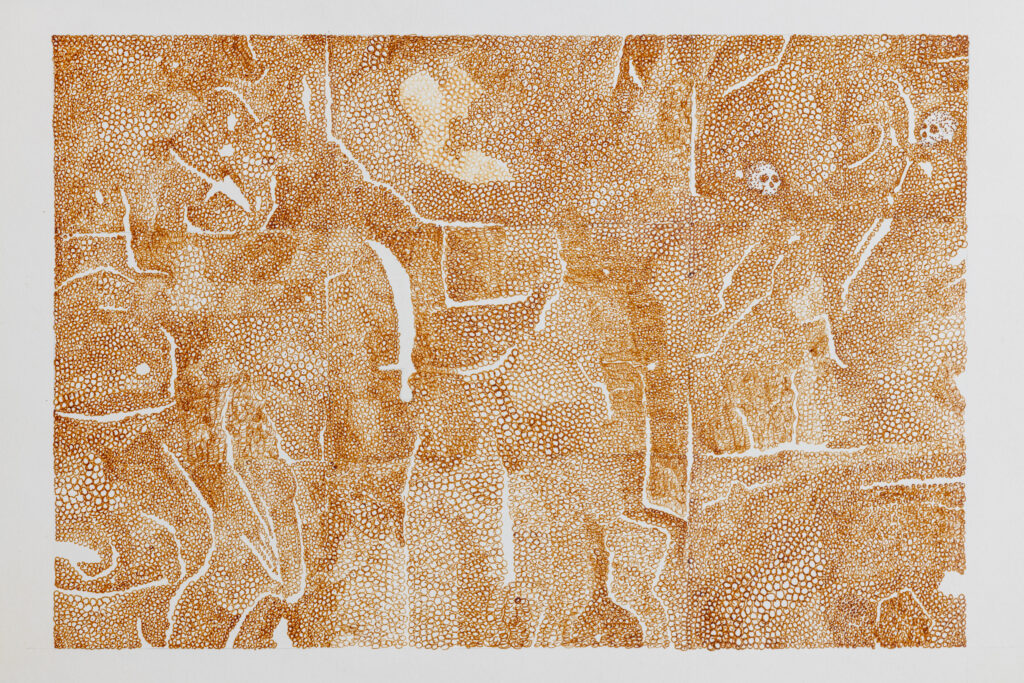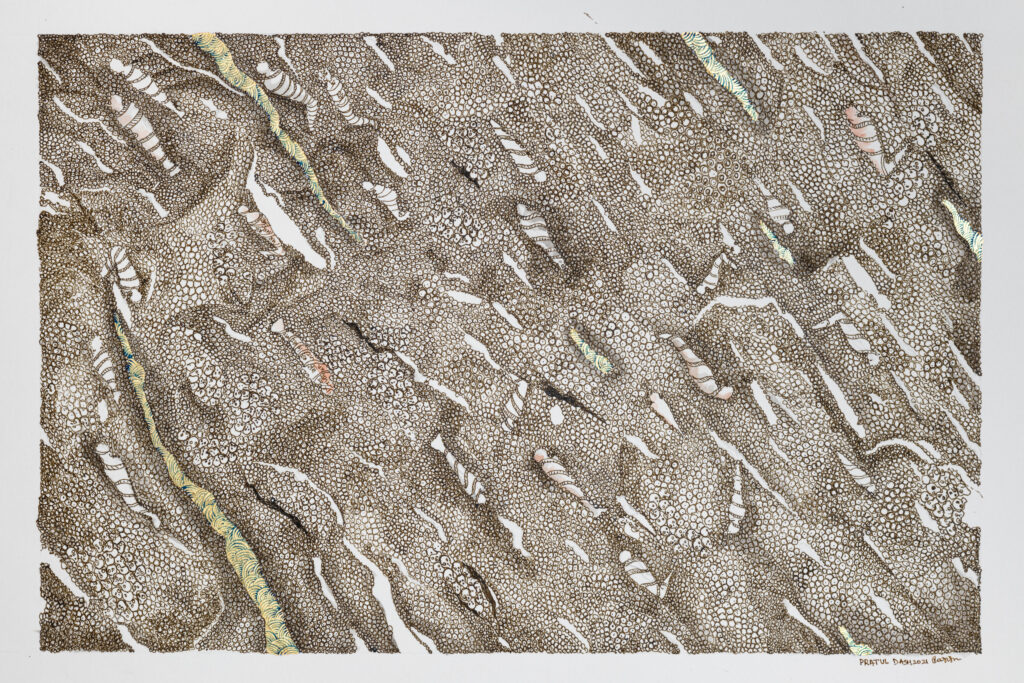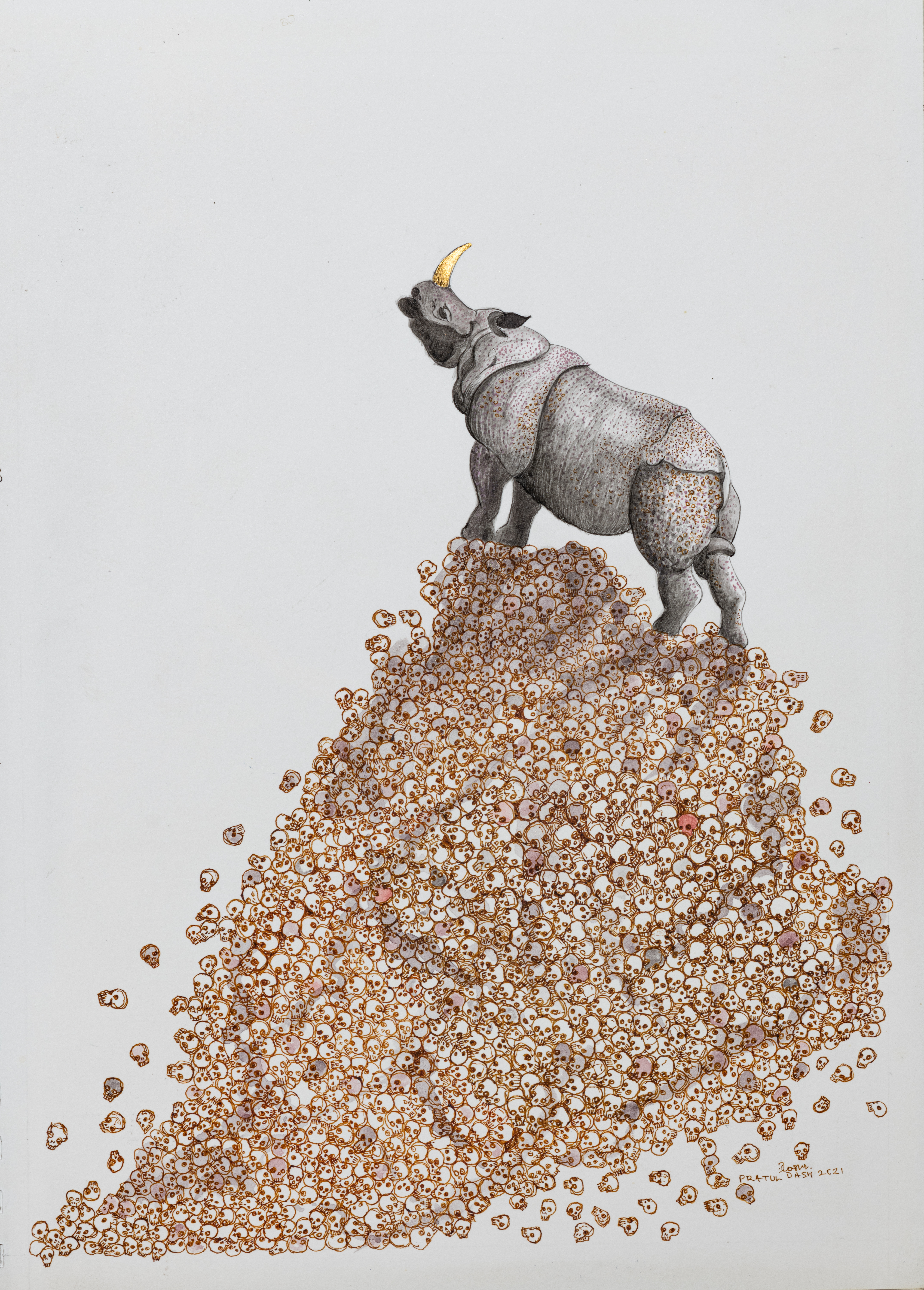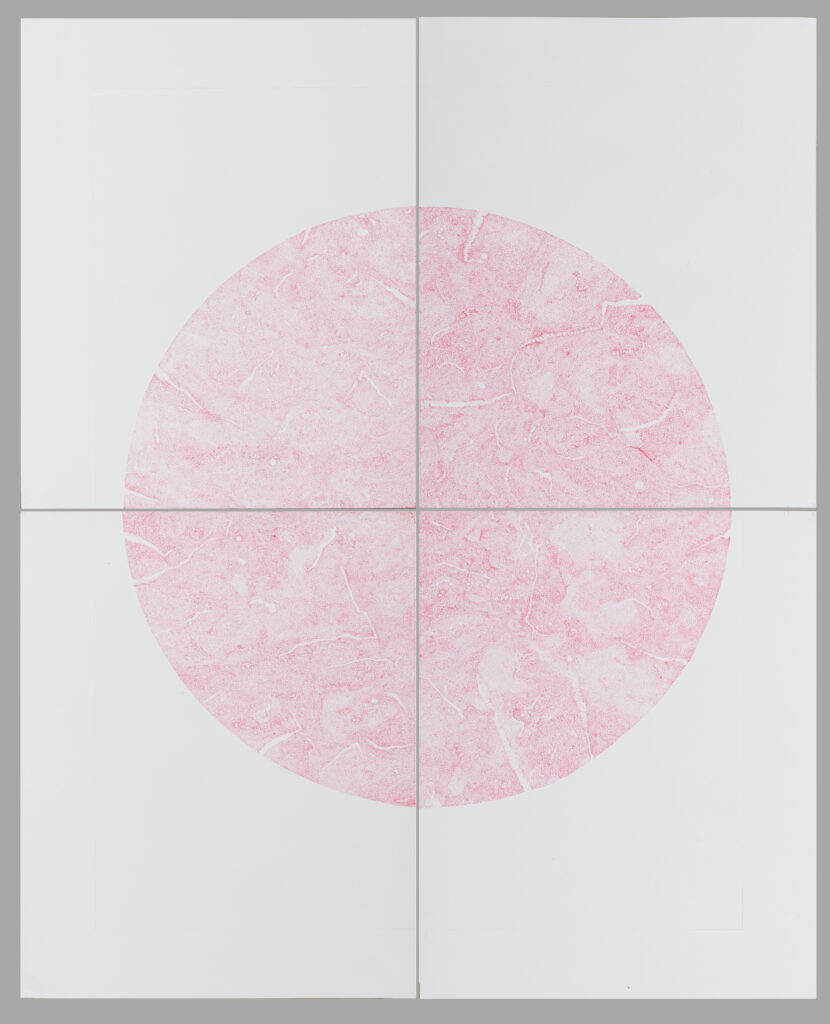A Bend in the River
Oct 30, 2023 - Dec 15, 2023
- SELECTED WORKS
- CURATORIAL NOTE
- PRESS RELEASE
- DOWNLOAD CATALOGUE
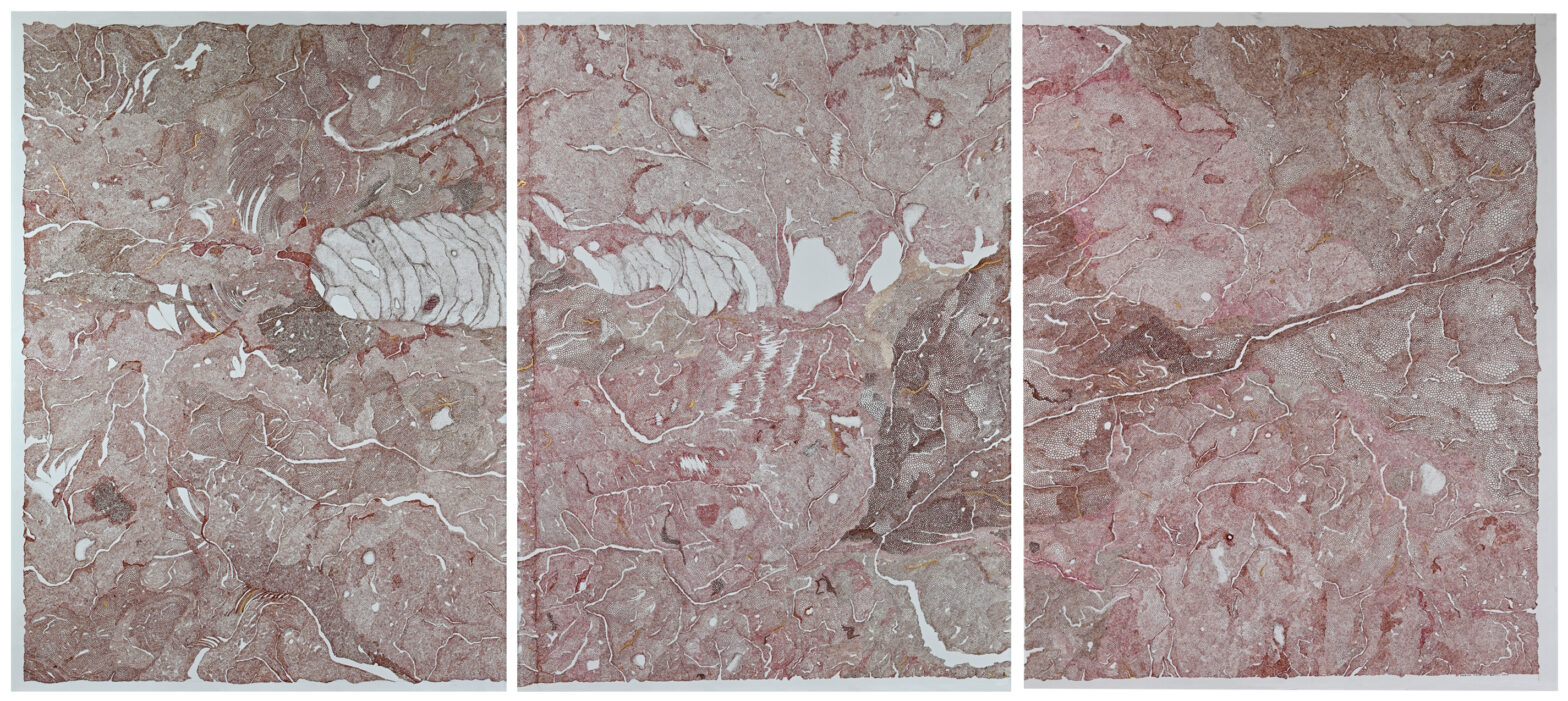
Step into the captivating realm of Pratul Dash’s “A Bend in the River” exhibition. Dash’s abstract artworks invite you to explore an alternate view of reality, blending his intricate reflections on everyday life, abstract concepts, and philosophical observations. In this exhibition, Dash’s evolving style converges with landscapes, memories, and contemporary commentaries, creating a thought-provoking commentary on our complex world.
CURATORIAL NOTE
Viewers familiar with Pratul Dash’s oeuvre will discover a startling change in his present solo exhibition. The artist is associated with a lush-hued figurative style combining politically engaged realism with Daliesque reverie. In contrast, his creations of the past three years are monochromatic semi-abstract landscapes, frequently constituted by tiny circular forms, painstakingly drawn, reminiscent of blood cells seen under high magnification. The new compositions, epic in scale, conjure night skies, caverns and grottos, cross sections of mountains, aerial views of alluvial tracts, and the earth seen from outer space.
Figures do appear, including motifs used in previous paintings such as an ostrich with its head buried in the ground, but are dwarfed by their surroundings. Since these figures carry the political heft of paintings like the enormous six-panel canvas 24×7: A Global Discourse, their relative inconspicuousness could signal the marginalisation of inconvenient truths in an era marked by polarisation and weaponised disinformation. However, it would be an injustice to dismiss the intricate, exquisite patterns that dominate each painting as mere distractions from real issues represented by the figures. The foregrounding of the background, as it were, suggests that the artist is placing the present moment and immediate social concerns within a bigger picture involving nature’s sublimity, which is undiminished by humanity’s depredations. These two readings are contradictory yet simultaneously valid – like alternate orientations of a Necker cube – and taken together capture some of the complexity of signification generated by the show.
Although the latest suite of paintings marks a leap into the unknown in terms of Dash’s exhibition history, it results from years of experiments carried out in his studio but kept private. This long secluded effort partly explains why the images demonstrate such self-assurance despite departing radically from his well-known style (‘partly’ being a necessary qualifier because success is never guaranteed even by constant practice). The shift from private exploration to public display was catalysed by the pandemic, a tragic rupture that would influence the form as well as subject matter of the new work.
At the start of the first covid-induced lockdown, the artist happened to be staying with his parents in his hometown Burla which sits on the banks of the Mahanadi, near the spot where the river, having flowed east through Chhattisgarh into Odisha, turns sharply southward. Burla’s history and economy are associated with its proximity to the Hirakud dam, one of the earliest major hydroelectric projects of independent India and still the longest earthen dam in the world. Confined to Burla for four months, away from his studio and paints, Dash slaked his thirst for creation by using Rotring pens left in the house from his student days, the inks for which he procured through a friend, one of the many engineers employed at the Hirakud site or in universities that arose in Burla consequent to the dam’s construction.
On his return to Delhi, he continued working with pen and ink, adding mineral pigment and watercolour and adjusting dilution levels for tonal variation. Among the earliest completed works in the new series were the four-panel Spherical Soliloquy I and Spherical Soliloquy II, of which the latter uses curvilinear forms that in the artist’s mind reflected the uncertainty and instability of the period. The pandemic took a turn for the worse when the Delta variant of the coronavirus ripped through India in March 2021. Health infrastructure crumbled, thousands died simply for want of medical oxygen, bodies were hastily buried in riverbanks or abandoned to float downstream because there was no space in crematoria or wood for pyres. While images of the calamity spread around the globe, some political leaders manipulated death counts and pretended things were under control. A widely circulated poem in Gujarati by Parul Khakhar titled Shab-vahini Ganga used gallows humour to capture the mood of that moment:
“Our life was never better”, say the corpses in one breath
O King, in your domain the Ganga carries only death
Skulls and bones embedded in soil appeared in Dash’s paintings as a reaction to the devastation wrought by the Delta wave. Tidal Trance, perhaps the most dystopian image in the sequence, is directly influenced by news photographs of bodies strewn across the Ganga’s banks. Memory of Unrecorded Records is a closer view of a similar scene, its title a nod to those among the covid dead who did not even become statistics in the official record. The painting depicts what appears to be a shrouded corpse half-buried in sand. However, the folds of the shroud endow the figure with the semblance of a larva or cocoon, making it as much an emblem of incipient flourishing as one of demise and dissolution, bringing to mind T.S. Eliot’s poem East Coker which commences, In my beginning is my end, and concludes, In my end is my beginning. The sense of a cycle of life which pervades the exhibition is made explicit in a twelve-panel painting, Of Blood, Of Birth, Of Death, not only in the title but through the pairing of skeletons and butterflies within what feels like a primeval setting far removed from the here and now.
Butterflies as symbols of life have appeared consistently in Dash’s paintings, and also feature in a canvas titled Hope in a Tempest, one of two works that depart significantly from the bulk of the show. The subject, given the kind of prominence one has come to expect in a Pratul Dash piece, is a young boy whose arms are expansively outstretched while his eyes are closed and the contours of his body bleed into the swirling tumult around him. In keeping with the double-edgedness of the exhibition, the boy’s gesture is concurrently one of liberatory exultation and acquiescent acceptance.
The second outlier is Disrupted Meta-Memorabilia – A Journey through Time and Transformation, an impressionistic video sketch of the pandemic months and of the prolonged protest by north Indian farmers against proposed changes in agricultural laws. The artist, who documented the demonstrations extensively, was particularly drawn to elderly farmers, some in their nineties, bearing the heat, rain and cold with calm determination. Some make an appearance in the video, the deep lines on their faces testaments of hard-won experience.
Taken as a whole, A Bend in the River confidently balances different scales of time and space, engaging with troubling current events while cultivating a philosophical distance that provides grounds for equanimity and even optimism.
– By Girish Shahane
